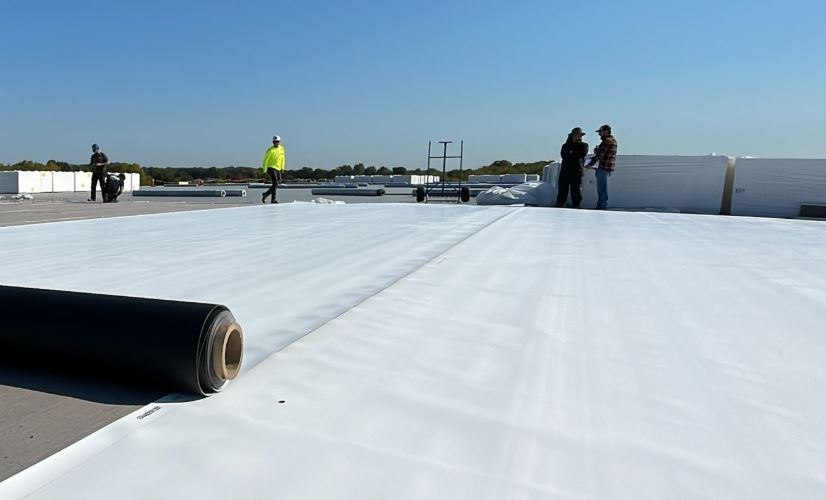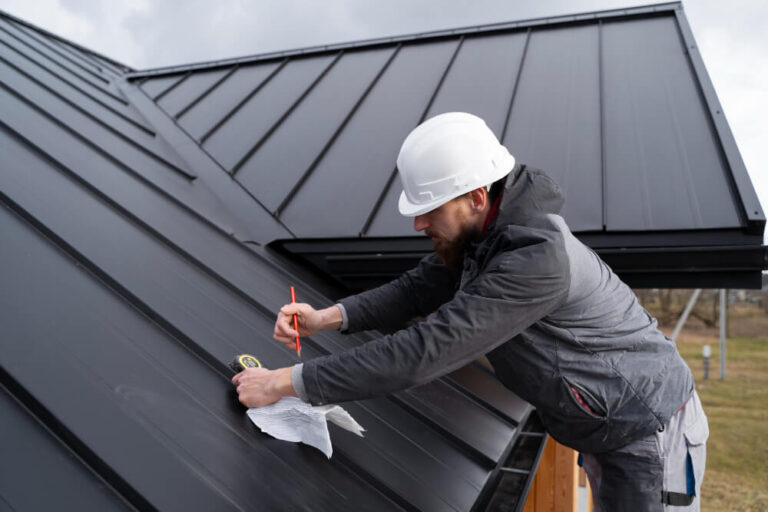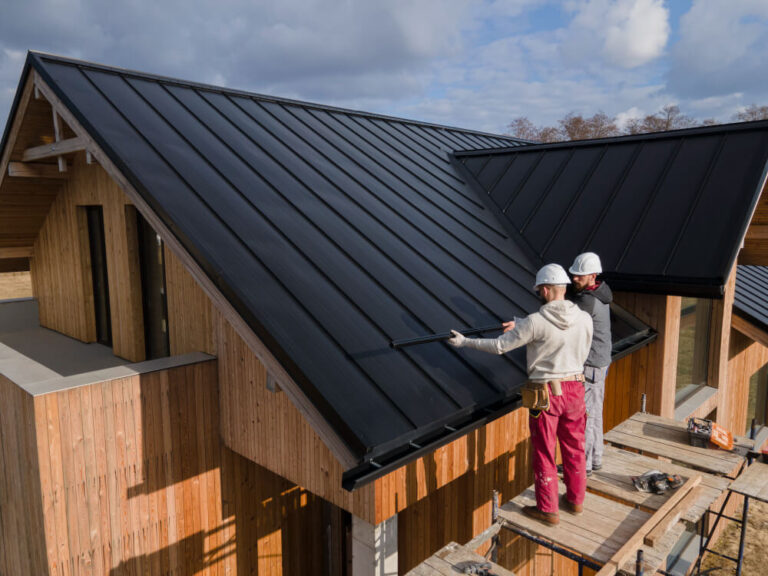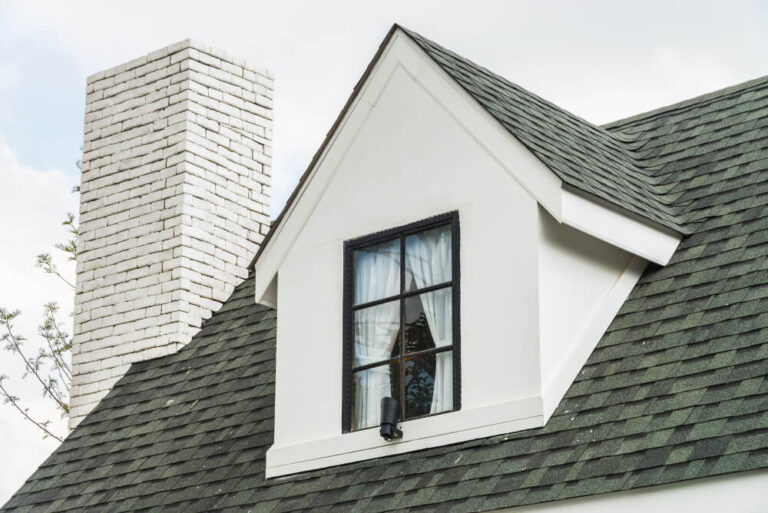What Is TPO Roofing?
Understanding TPO Technology
TPO roofing represents one of the most significant advances in commercial roofing technology over the past three decades. This single-ply roofing membrane combines the weatherability of EPDM (rubber roofing) with the heat-weldable properties of PVC, creating a roofing system that offers the best of both worlds.
TPO Composition:
- Base polymer: Polypropylene and ethylene-propylene rubber
- Reinforcement: Polyester or fiberglass scrim layer
- Additives: UV absorbers, flame retardants, and colorants
- Thickness: Available in 45, 60, and 80 mil options
- Colors: White (most common), tan, and gray
The Evolution of TPO Roofing
TPO roofing was introduced to the U.S. market in the early 1990s as manufacturers sought to develop a roofing membrane that combined the best qualities of PVC and EPDM while eliminating their drawbacks. The technology has evolved significantly through multiple generations:
- First Generation (1990s): Initial formulations with limited UV stability
- Second Generation (2000s): Improved weathering packages and durability
- Third Generation (2010s): Enhanced flexibility and heat aging resistance
- Current Generation: Advanced formulations with superior longevity
TPO Roofing System Components
1. TPO Membrane
The TPO membrane itself consists of three layers laminated together:
- Top layer: TPO compound with UV stabilizers and weathering protection
- Middle layer: Polyester or fiberglass reinforcement scrim
- Bottom layer: TPO compound for adhesion and stability
2. Insulation Options
Compatible Insulation Types:
- Polyisocyanurate (Polyiso): Most common, high R-value
- Expanded Polystyrene (EPS): Cost-effective option
- Extruded Polystyrene (XPS): Moisture-resistant
- Mineral Wool: Fire-resistant option
- High-Density Polyiso: For recover applications
3. Attachment Methods
| Method | Description | Best Use | Wind Rating |
|---|---|---|---|
| Mechanically Attached | Fasteners and plates through membrane | Most applications | Up to 200 mph |
| Fully Adhered | Bonding adhesive | Contoured roofs | Up to 150 mph |
| Induction Welded | Electromagnetic fastening | Quick installation | Up to 175 mph |
| Ballasted | Loose-laid with stone | Low-wind areas | Up to 75 mph |
Benefits of TPO Roofing
✓ Advantages
- Energy Efficiency: White TPO reflects 78%+ of sun’s heat
- Cost-Effective: Lower material and installation costs
- Durability: Resists tears, punctures, and impacts
- Chemical Resistance: Withstands oils, greases, and chemicals
- Flexibility: Remains flexible in cold weather
- Environmentally Friendly: 100% recyclable
- Heat-Welded Seams: Stronger than taped or glued seams
- Lightweight: Minimal structural load
- Low Maintenance: Simple cleaning requirements
✗ Disadvantages
- Newer Technology: Less long-term data than EPDM
- Heat Sensitivity: Can be damaged by excessive heat
- Seam Failures: Poor installation causes problems
- Limited Colors: Mainly white, tan, gray
- UV Degradation: Quality varies by manufacturer
- Repair Difficulty: Requires heat welding equipment
- Foot Traffic: Can be damaged without walk pads
- Thickness Variations: Thinner options less durable
TPO Roofing Installation Process
Pre-Installation Steps
- Roof Deck Inspection:
- Check for structural integrity
- Repair any damaged decking
- Ensure proper slope (minimum ¼” per foot)
- Tear-Off (if required):
- Remove existing roofing materials
- Inspect and repair deck
- Install new drains if needed
- Vapor Barrier Installation:
- Required in certain climates
- Prevents moisture migration
Installation Steps
Step 1: Insulation Installation
- Mechanically fasten or adhere insulation boards
- Stagger joints to prevent thermal bridging
- Install tapered insulation for drainage if needed
- Add cover board for enhanced durability
Step 2: Membrane Placement
- Roll out TPO sheets with 6″ overlap
- Allow membrane to relax (30 minutes minimum)
- Position sheets parallel to roof slope
- Ensure proper alignment before fastening
Step 3: Securing the Membrane
- Field of roof: 12″ O.C. maximum
- Perimeter: 6″ O.C. maximum
- Corners: 6″ O.C. in enhanced pattern
- Follow manufacturer’s wind uplift requirements
Step 4: Heat Welding Seams
- Use automatic hot-air welder for long seams
- Temperature: 900-1100°F typically
- Speed: 10-15 feet per minute
- Hand weld details and penetrations
- Test all seams with probe
TPO Roofing Costs
Material Costs
| Component | Cost per Square Foot | Notes |
|---|---|---|
| 45 mil TPO Membrane | $0.75 – $1.10 | Residential/light commercial |
| 60 mil TPO Membrane | $1.00 – $1.40 | Standard commercial |
| 80 mil TPO Membrane | $1.30 – $1.80 | Heavy-duty applications |
| Insulation (per inch) | $0.55 – $0.85 | Polyiso most common |
| Cover Board | $0.75 – $1.25 | Recommended for durability |
| Accessories/Flashings | $0.30 – $0.50 | Varies by complexity |
Total Installation Costs
Typical Project Pricing (per square foot):
- Basic Installation (45 mil): $4.50 – $6.50
- Standard Commercial (60 mil): $5.50 – $8.00
- Premium System (80 mil + cover board): $7.00 – $10.00
- Tear-off and Replace: Add $1.50 – $3.00
Note: Prices vary by region, roof complexity, and project size
Cost Factors
- Roof Size: Larger roofs have lower per-square-foot costs
- Accessibility: Difficult access increases labor costs
- Existing Conditions: Tear-off needs add significant cost
- Insulation Requirements: R-value needs affect total price
- Warranty Level: Extended warranties increase material costs
- Time of Year: Winter installations may cost more
TPO vs Other Commercial Roofing Systems
| Feature | TPO | EPDM | PVC | Modified Bitumen |
|---|---|---|---|---|
| Cost | $$ | $ | $$$ | $$ |
| Energy Efficiency | Excellent | Poor (black) | Excellent | Moderate |
| Durability | Very Good | Excellent | Very Good | Good |
| Lifespan | 15-30 years | 20-35 years | 20-30 years | 15-20 years |
| Seam Strength | Excellent | Good | Excellent | Good |
| Chemical Resistance | Very Good | Fair | Excellent | Good |
| Repair Ease | Moderate | Easy | Moderate | Easy |
| Flexibility | Excellent | Excellent | Good | Fair |
Energy Efficiency and Environmental Impact
Energy Savings
TPO’s white surface provides exceptional energy efficiency benefits:
- Solar Reflectance Index (SRI): 104-110 for white TPO
- Energy Star Qualified: Meets cool roof requirements
- HVAC Savings: 15-30% reduction in cooling costs
- Urban Heat Island: Reduces ambient temperatures
- Peak Demand: Lowers strain on electrical grid
A 20,000 sq ft building in Phoenix replacing black EPDM with white TPO:
- Annual cooling cost reduction: $3,000-5,000
- Peak temperature reduction: 30-50°F on roof surface
- Simple payback: 3-5 years from energy savings alone
Environmental Benefits
- Recyclability: 100% recyclable at end of life
- No Chlorine: Unlike PVC, contains no chlorine
- Low VOCs: Minimal emissions during installation
- LEED Points: Contributes to sustainable building credits
- Reduced Landfill: Can often install over existing roof
Maintenance and Longevity
Routine Maintenance Requirements
Maintenance Schedule:
- Monthly: Visual inspection from ground level
- Quarterly: Check drains and remove debris
- Semi-Annual: Detailed roof inspection
- Annual: Professional inspection and cleaning
- After Storms: Check for damage immediately
Cleaning TPO Roofing
- Remove Debris: Clear leaves, branches, and dirt
- Light Cleaning: Low-pressure water (under 2,000 PSI)
- Deep Cleaning: Mild detergent with soft brushes
- Avoid: Petroleum-based cleaners, high pressure, abrasives
- Frequency: 1-2 times per year typically sufficient
Common TPO Roofing Problems
Issues to Watch For:
- Seam Failures: Due to improper welding or material fatigue
- Solution: Re-weld or patch affected areas
- Membrane Crazing: Surface cracking from UV degradation
- Solution: Apply restoration coating or replace
- Punctures: From foot traffic or dropped tools
- Solution: Heat-weld patches over damage
- Ponding Water: Due to inadequate drainage
- Solution: Add tapered insulation or drains
Warranty Considerations
Types of TPO Warranties
| Warranty Type | Coverage | Duration | Cost |
|---|---|---|---|
| Material Only | Membrane defects | 10-15 years | Included |
| System Warranty | Materials + accessories | 15-20 years | $0.05-0.10/sq ft |
| Labor & Material | Full coverage | 15-20 years | $0.15-0.25/sq ft |
| NDL (No Dollar Limit) | Complete protection | 15-30 years | $0.25-0.40/sq ft |
Warranty Requirements
- Certified Installer: Must use approved contractors
- Inspections: Manufacturer inspection often required
- Maintenance: Annual inspections mandatory
- Documentation: Keep all maintenance records
- Prompt Repairs: Address issues within specified timeframe
When to Choose TPO Roofing
Ideal Applications
- Large commercial buildings seeking energy efficiency
- Facilities with high cooling costs
- Buildings requiring chemical resistance
- Projects with tight budgets but quality needs
- Roofs with multiple penetrations requiring welded seams
- Green building projects seeking LEED certification
- Recover projects over existing roofing
When to Consider Alternatives
- Heavy rooftop traffic: Consider PVC or built-up roofing
- Extreme chemical exposure: PVC may be better
- Longest possible lifespan: EPDM or modified bitumen
- Aesthetic requirements: Standing seam metal
- Historical buildings: Traditional built-up roofing
Frequently Asked Questions
Q: How long does TPO roofing last?
A: TPO roofing typically lasts 15-30 years, depending on thickness, installation quality, maintenance, and environmental conditions. White 60-mil TPO with proper maintenance commonly reaches 20-25 years. Thicker 80-mil membranes can last 25-30 years in ideal conditions.
Q: Is TPO roofing good for residential homes?
A: Yes, TPO works well for residential flat or low-slope roofs, particularly on modern homes, additions, or garages. However, it’s not suitable for steep-slope roofs where traditional shingles are used. TPO is ideal for residential applications prioritizing energy efficiency.
Q: Can TPO roofing be repaired?
A: Yes, TPO can be repaired using heat-welded patches or TPO repair tape for minor issues. Larger repairs require professional heat welding equipment and expertise. Unlike some roofing systems, TPO repairs create permanent, watertight bonds when done correctly.
Q: What’s the difference between TPO and PVC roofing?
A: While both are heat-welded single-ply membranes, TPO contains no chlorine and is generally more flexible and less expensive. PVC offers superior chemical resistance and fire ratings but costs more. TPO has better cold-weather flexibility, while PVC excels in chemical environments.
Q: Does TPO roofing come in colors other than white?
A: Yes, TPO is available in white (most common), tan, and gray. White provides the best energy efficiency with highest reflectivity. Tan and gray offer aesthetic alternatives while still providing good performance, though with slightly reduced energy savings.
Q: How much weight does TPO roofing add to a building?
A: TPO membrane adds minimal weight – approximately 0.29 lbs/sq ft for 45-mil, 0.40 lbs/sq ft for 60-mil, and 0.47 lbs/sq ft for 80-mil. This lightweight nature makes TPO ideal for retrofit projects where structural capacity is a concern.
Q: Can you walk on TPO roofing?
A: Yes, but with precautions. TPO can handle occasional foot traffic for maintenance, but high-traffic areas need walk pads to prevent damage. Avoid walking on TPO during extreme temperatures, and never drag equipment across the membrane.
Q: Is TPO roofing slippery when wet?
A: Yes, TPO can be very slippery when wet, creating safety hazards. Always use proper safety equipment including non-slip footwear and fall protection. Some manufacturers offer textured TPO membranes for improved traction in areas requiring regular access.
Q: What happens to old TPO roofing?
A: TPO is 100% recyclable. Old membranes can be ground up and recycled into new roofing products, walkway pads, or other plastic products. Many manufacturers have recycling programs, making TPO an environmentally responsible choice.
Q: Can solar panels be installed on TPO roofing?
A: Yes, solar panels can be installed on TPO roofs using non-penetrating ballasted systems or specially designed mounting systems that integrate with the membrane. Always consult the roofing manufacturer for approved attachment methods to maintain warranty coverage.
The Future of TPO Roofing
Emerging Technologies
- Self-Healing Membranes: Development of TPO that repairs minor damage
- Smart Sensors: Embedded moisture and temperature monitoring
- Enhanced Formulations: Improved UV resistance and longevity
- Sustainable Additives: Bio-based components reducing petroleum use
- Photovoltaic Integration: TPO with built-in solar cells
Market Trends
- Growing Market Share: TPO now over 40% of commercial roofing
- Thickness Evolution: Trend toward thicker, longer-lasting membranes
- Color Options: Development of more architectural colors
- Installation Innovation: Robotic welding and automated systems
- Sustainability Focus: Increased emphasis on recyclability
Conclusion: Is TPO Roofing Right for Your Project?
TPO roofing has revolutionized the commercial roofing industry by offering an optimal balance of performance, cost-effectiveness, and environmental responsibility. Its rapid growth to become the leading single-ply roofing system demonstrates its value proposition for building owners and contractors alike.
Key Takeaways:
- Versatility: Suitable for most flat and low-slope applications
- Energy Efficiency: Outstanding reflectivity reduces cooling costs
- Durability: Heat-welded seams provide superior waterproofing
- Value: Competitive pricing with excellent performance
- Sustainability: 100% recyclable with minimal environmental impact
- Technology: Continuing improvements in formulation and installation
Whether you’re planning a new construction project, replacing an aging roof, or seeking to improve your building’s energy efficiency, TPO roofing deserves serious consideration. Its proven track record, comprehensive warranty options, and excellent ROI through energy savings make it a smart choice for many commercial and residential flat roofing applications.
As with any roofing decision, success depends on proper design, quality materials, and professional installation. Work with certified TPO installers, choose appropriate membrane thickness for your needs, and maintain the system properly to maximize your investment. With these elements in place, TPO roofing can provide decades of reliable, energy-efficient protection for your building.






